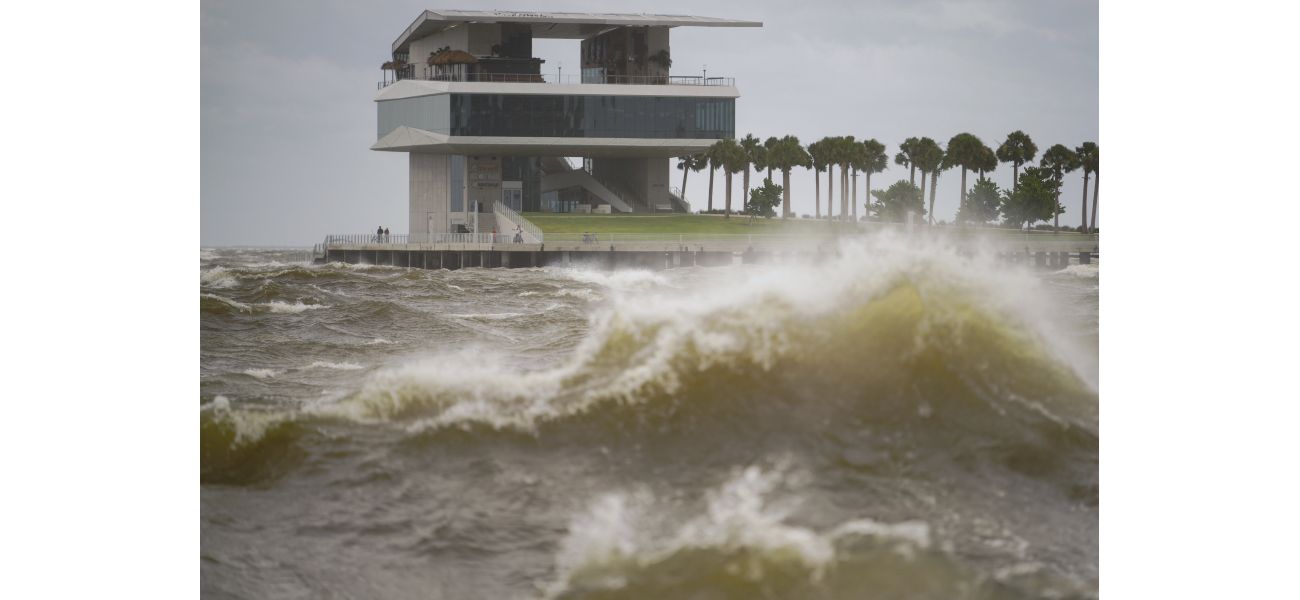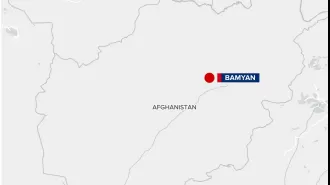Hurricane Helene hits northwestern Florida as a Category 4 storm.
Strong winds have caused power outages in several states, leading to a state of emergency being declared and affecting over 250,000 properties.
September 27th 2024.

On Thursday evening, the fast-moving Hurricane Helene made its way onto the northwestern coast of Florida in the Big Bend area. As a Category 4 storm, it posed a serious threat with its destructive winds, heavy rains, and potential for flash floods that could reach hundreds of miles inland throughout the southeastern US, according to forecasters.
The storm's approach was met with tragedy in south Georgia as authorities reported two deaths, possibly caused by a tornado. In Florida, Governor Ron DeSantis announced that one person had died on Interstate 4 when their car was struck by a falling sign. As Helene made landfall, it knocked out power to over 1 million homes and businesses in Florida and over 50,000 in Georgia, according to poweroutage.us.
The severity of the situation prompted states of emergency to be declared in Florida, Georgia, the Carolinas, Virginia, and Alabama. Meanwhile, in the Pacific, former Hurricane John re-strengthened into a hurricane on Thursday morning, posing a threat of flash flooding and mudslides along Mexico's western coast. It was later downgraded to a tropical storm as it moved along the coast of Michoacan.
As Helene continued to wreak havoc in Florida, Tropical Storm Isaac formed in the Atlantic Ocean on Wednesday. Forecasters predicted that it would gain strength as it moved away from the US and could potentially become a hurricane by the end of the week.
In the midst of the chaos, Governor DeSantis addressed the public, urging them to stay safe and be cautious of the dangerous conditions. He also mentioned that there were more fatalities possible as the storm progressed and that 3,500 National Guardsmen were prepared to assist in the aftermath.
DeSantis also emphasized the potential loss of life and property as a result of the storm, urging people to keep those affected in their thoughts and prayers. Meanwhile, Helene made landfall Thursday night in northwestern Florida as a Category 4 storm, with maximum sustained winds of 140 mph. The National Hurricane Center warned of potential storm surges of up to 20 feet, particularly in Florida's Apalachee Bay.
The impact of the storm extended beyond the coast, with hurricane warnings and flash flood warnings reaching as far as northern Georgia and western North Carolina. As the night went on, the number of power outages in Florida continued to rise, with over 885,000 customers without electricity, according to poweroutage.us. The site's map showed that a majority of customers in the Big Bend area, where Helene made landfall, were affected.
In the Pacific, former Hurricane John was downgraded to a tropical storm on Thursday evening as it moved slowly along the coast of Michoacan. The US National Hurricane Center reported sustained wind speeds of 70 mph and warned of severe flash flooding in coastal areas. John first hit Mexico as a Category 3 hurricane on Monday, causing significant damage. After weakening and moving inland, it reemerged over the ocean and regained strength as a tropical storm before being downgraded again.
Despite the storm's weakening, the hurricane center advised that it could still pose a threat, and urged people to stay informed and prepared. As the situation continued to unfold, it became clear that the impact of Hurricane Helene and Tropical Storm Isaac would be felt for days to come, and the aftermath would require extensive rebuilding and recovery efforts.
On Thursday evening, the fast-moving Hurricane Helene made its way to the Big Bend area of Florida's northwestern coast. It was classified as a Category 4 storm, bringing with it the potential for catastrophic damage. Forecasters warned of a dangerous storm surge, powerful winds, heavy rains, and flash floods that could reach hundreds of miles inland across the southeastern United States.
As Helene approached, authorities in Georgia reported two fatalities, possibly due to a tornado, and Florida Governor Ron DeSantis confirmed one death from a fallen sign on Interstate 4. The storm also caused widespread power outages, affecting over 1 million homes and businesses in Florida and over 50,000 in Georgia.
Multiple states, including Florida, Georgia, the Carolinas, Virginia, and Alabama, declared states of emergency in preparation for the storm's impact. In the Pacific, another storm, former Hurricane John, strengthened into a hurricane once again and threatened parts of Mexico's western coast with flash flooding and mudslides.
Meanwhile, a new tropical storm, Isaac, formed in the Atlantic Ocean on Wednesday and was expected to gain strength as it moved away from the United States. Forecasters predict it may become a hurricane by the end of the week.
Governor DeSantis urged people to stay safe and take necessary precautions as the storm continued to advance. He also expressed concern for the potential loss of life and property, with more fatalities and property damage likely to occur. 3,500 National Guardsmen were on standby to assist with response efforts.
As Helene made landfall in northwestern Florida, the National Hurricane Center warned of catastrophic flooding along the Gulf Coast. The storm hit near Perry, Florida, with maximum sustained winds of 140 mph. Officials also issued warnings of storm surges up to 20 feet, particularly in Florida's Apalachee Bay.
Hurricane and flash flood warnings extended beyond the coast, reaching up into northern Georgia and western North Carolina. As of late Thursday night, power outages continued to rise, with over 885,000 customers in Florida without power.
Meanwhile, former Hurricane John was downgraded to a tropical storm as it slowly moved along the coast of Mexico's Michoacan state. Despite weakening, it still posed a significant threat of flash flooding, with sustained wind speeds of 70 mph. The storm first hit Mexico on Monday as a Category 3 hurricane, causing damage and destruction before reemerging over the ocean and reforming as a tropical storm.
The National Hurricane Center expects John to continue to weaken as it moves along the coast. The storm has already caused devastation in its wake, and it serves as a reminder of the power and destruction that can come with these natural disasters.
The storm's approach was met with tragedy in south Georgia as authorities reported two deaths, possibly caused by a tornado. In Florida, Governor Ron DeSantis announced that one person had died on Interstate 4 when their car was struck by a falling sign. As Helene made landfall, it knocked out power to over 1 million homes and businesses in Florida and over 50,000 in Georgia, according to poweroutage.us.
The severity of the situation prompted states of emergency to be declared in Florida, Georgia, the Carolinas, Virginia, and Alabama. Meanwhile, in the Pacific, former Hurricane John re-strengthened into a hurricane on Thursday morning, posing a threat of flash flooding and mudslides along Mexico's western coast. It was later downgraded to a tropical storm as it moved along the coast of Michoacan.
As Helene continued to wreak havoc in Florida, Tropical Storm Isaac formed in the Atlantic Ocean on Wednesday. Forecasters predicted that it would gain strength as it moved away from the US and could potentially become a hurricane by the end of the week.
In the midst of the chaos, Governor DeSantis addressed the public, urging them to stay safe and be cautious of the dangerous conditions. He also mentioned that there were more fatalities possible as the storm progressed and that 3,500 National Guardsmen were prepared to assist in the aftermath.
DeSantis also emphasized the potential loss of life and property as a result of the storm, urging people to keep those affected in their thoughts and prayers. Meanwhile, Helene made landfall Thursday night in northwestern Florida as a Category 4 storm, with maximum sustained winds of 140 mph. The National Hurricane Center warned of potential storm surges of up to 20 feet, particularly in Florida's Apalachee Bay.
The impact of the storm extended beyond the coast, with hurricane warnings and flash flood warnings reaching as far as northern Georgia and western North Carolina. As the night went on, the number of power outages in Florida continued to rise, with over 885,000 customers without electricity, according to poweroutage.us. The site's map showed that a majority of customers in the Big Bend area, where Helene made landfall, were affected.
In the Pacific, former Hurricane John was downgraded to a tropical storm on Thursday evening as it moved slowly along the coast of Michoacan. The US National Hurricane Center reported sustained wind speeds of 70 mph and warned of severe flash flooding in coastal areas. John first hit Mexico as a Category 3 hurricane on Monday, causing significant damage. After weakening and moving inland, it reemerged over the ocean and regained strength as a tropical storm before being downgraded again.
Despite the storm's weakening, the hurricane center advised that it could still pose a threat, and urged people to stay informed and prepared. As the situation continued to unfold, it became clear that the impact of Hurricane Helene and Tropical Storm Isaac would be felt for days to come, and the aftermath would require extensive rebuilding and recovery efforts.
On Thursday evening, the fast-moving Hurricane Helene made its way to the Big Bend area of Florida's northwestern coast. It was classified as a Category 4 storm, bringing with it the potential for catastrophic damage. Forecasters warned of a dangerous storm surge, powerful winds, heavy rains, and flash floods that could reach hundreds of miles inland across the southeastern United States.
As Helene approached, authorities in Georgia reported two fatalities, possibly due to a tornado, and Florida Governor Ron DeSantis confirmed one death from a fallen sign on Interstate 4. The storm also caused widespread power outages, affecting over 1 million homes and businesses in Florida and over 50,000 in Georgia.
Multiple states, including Florida, Georgia, the Carolinas, Virginia, and Alabama, declared states of emergency in preparation for the storm's impact. In the Pacific, another storm, former Hurricane John, strengthened into a hurricane once again and threatened parts of Mexico's western coast with flash flooding and mudslides.
Meanwhile, a new tropical storm, Isaac, formed in the Atlantic Ocean on Wednesday and was expected to gain strength as it moved away from the United States. Forecasters predict it may become a hurricane by the end of the week.
Governor DeSantis urged people to stay safe and take necessary precautions as the storm continued to advance. He also expressed concern for the potential loss of life and property, with more fatalities and property damage likely to occur. 3,500 National Guardsmen were on standby to assist with response efforts.
As Helene made landfall in northwestern Florida, the National Hurricane Center warned of catastrophic flooding along the Gulf Coast. The storm hit near Perry, Florida, with maximum sustained winds of 140 mph. Officials also issued warnings of storm surges up to 20 feet, particularly in Florida's Apalachee Bay.
Hurricane and flash flood warnings extended beyond the coast, reaching up into northern Georgia and western North Carolina. As of late Thursday night, power outages continued to rise, with over 885,000 customers in Florida without power.
Meanwhile, former Hurricane John was downgraded to a tropical storm as it slowly moved along the coast of Mexico's Michoacan state. Despite weakening, it still posed a significant threat of flash flooding, with sustained wind speeds of 70 mph. The storm first hit Mexico on Monday as a Category 3 hurricane, causing damage and destruction before reemerging over the ocean and reforming as a tropical storm.
The National Hurricane Center expects John to continue to weaken as it moves along the coast. The storm has already caused devastation in its wake, and it serves as a reminder of the power and destruction that can come with these natural disasters.
[This article has been trending online recently and has been generated with AI. Your feed is customized.]
[Generative AI is experimental.]
0
0
Submit Comment





